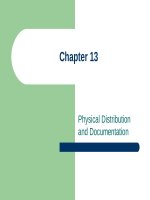Lecture Marketing research - Chapter 13: Bivariate correlation and regression
Bạn đang xem bản rút gọn của tài liệu. Xem và tải ngay bản đầy đủ của tài liệu tại đây (260.07 KB, 27 trang )
CHAPTER Thirteen
Learning Objectives
Bivariate
Correlation and
Regression
Copyright © 2004
John Wiley & Sons, Inc.
Learning Objectives
Learning Objectives
1. To comprehend the nature of correlation
analysis.
2. To understand bivariate regression analysis.
3. To become aware of the coefficient of
determination, R2.
Learning Objectives
Bivariate Analysis of
Association
To understand bivariate
regression analysis.
Bivariate Analysis Defined
The degree of association between two variables
Bivariate techniques
Statistical methods of analyzing the relationship
between two variables.
Multivariate Techniques
When more than two variables are involved
Independent variable
Affects the value of the dependent variable
Dependent variable
explained or caused by the independent variable
Learning Objectives
Bivariate Analysis of
Association
To understand bivariate
regression analysis.
Types of Bivariate Procedures
• Two group t-tests
• chi-square analysis of cross-tabulation or
contingency tables
• ANOVA (analysis of variance) for two groups
• Bivariate regression
• Pearson product moment correlation
Learning Objectives
Bivariate Regression
To understand bivariate
regression analysis.
Bivariate Regression Defined
Analyzing the strength of the linear relationship between
the dependent variable and the independent variable.
Nature of the Relationship
• Plot in a scatter diagram
• Dependent variable
Y is plotted on the vertical axis
• Independent variable
X is plotted on the horizontal axis
• Nonlinear relationship
Learning Objectives
Bivariate Regression
To understand bivariate
regression analysis.
Bivariate Regression Example
Figure 13.1
Types of Relationships Found in Scatter Diagrams
Y
X
A - Strong Positive Linear Relationship
Learning Objectives
Bivariate Regression
To understand bivariate
regression analysis.
Figure 13.1
Types of Relationships Found in Scatter Diagrams
Y
X
B - Positive Linear Relationship
Learning Objectives
Bivariate Regression
To understand bivariate
regression analysis.
Figure 13.1
Types of Relationships Found in Scatter Diagrams
Y
X
C - Perfect Negative Linear Relationship
Learning Objectives
Bivariate Regression
To understand bivariate
regression analysis.
Figure 13.1
Types of Relationships Found in Scatter Diagrams
X
D - Perfect Parabolic Relationship
Learning Objectives
Bivariate Regression
To understand bivariate
regression analysis.
Figure 13.1
Types of Relationships Found in Scatter Diagrams
Y
X
E - Negative Curvilinear Relationship
Learning Objectives
Bivariate Regression
To understand bivariate
regression analysis.
Figure 13.1
Types of Relationships Found in Scatter Diagrams
Y
X
F - No Relationship between X and Y
Learning Objectives
Bivariate Regression
To understand bivariate
regression analysis.
Least Squares Estimation Procedure
Results in a straight line that fits the actual observations
better than any other line that could be fitted to the
observations.
Y = a + bX + e
where
Y = dependent variable
a = estimated Y intercept
b = estimated slope of the regression line
X = independent variable
e = error
Learning Objectives
Bivariate Regression
To understand bivariate
regression analysis.
Values for a and b can be calculated as
follows:
b=
XiYi - nXY
X2i - n(X)2
a = Y - bX
X = mean of value X
Y = mean of value y
n = sample size
Learning Objectives
Bivariate Regression
To become aware of the coefficient
of determination, R2.
The Regression Line
Predicted values for Y, based on calculated
values.
Strength of Association: R2
Coefficient of Determination, R2:
The measure of the strength of the linear
relationship between X and Y.
Learning Objectives
Bivariate Regression
To become aware of the coefficient
of determination, R2.
explained variance
R =
total variance
2
explained variance =
total variance - unexplained variance
total variance - unexplained variance
R =
total variance
2
=
1-
unexplained variance
total variance
Learning Objectives
Bivariate Regression
R =
2
1-
To become aware of the coefficient
of determination, R2.
unexplained variance
total variance
n
(Yi - Yi)2
=
1-
I=1
n
(Yi - Y)2
I=1
Learning Objectives
Bivariate Regression
To become aware of the coefficient
of determination, R2.
Statistical Significance of Regression Results
Total variation =
Explained variation + Unexplained variation
The total variation is a measure of variation of the observed
Y values around their mean.
It measures the variation of the Y values without any
consideration of the X values.
Learning Objectives
Bivariate Regression
To become aware of the coefficient
of determination, R2.
Total variation: Sum of squares (SST)
SST =
n
i=1
(Yi - Y)2
n
n
=
2
Y
i
i=1
2
Y
i
i=1
n
Learning Objectives
Bivariate Regression
To become aware of the coefficient
of determination, R2.
Sum of squares due to regression (SSR)
SSR =
n
i=1
(Yi - Y)2
n
n
= a i = 1Yi +
n
bi = 1Xi Yi
2
i=1
Yi
n
Learning Objectives
Bivariate Regression
To become aware of the coefficient
of determination, R2.
Error sums of squares (SSE)
SSE =
n
i=1
(Yi - Y)2
n
=
n
Y
2
i=1
i
ai = 1Yi
n
bi = 1XiYi
Learning Objectives
Bivariate Regression
To become aware of the coefficient
of determination, R2.
Hypotheses Concerning the Overall Regression
Null Hypothesis Ho:
There is no linear relationship between X and Y.
Alternative Hypothesis Ha:
There is a linear relationship between X and Y.
Learning Objectives
Bivariate Regression
To become aware of the coefficient
of determination, R2.
Hypotheses about the Regression Coefficient
Null Hypothesis Ho:
b=0
Alternative Hypothesis Ha:
b
0
The appropriate test is the t-test.
Figure 13.4
Measures of Variation in aLearning
Regression
Objectives
Y
Yi =a + bXi
Unexplained
variation
Total
Variation
Explained
variation
Y
(X, Y)
a
0
X
Xi
X
Learning Objectives
Correlation Analysis
To become aware of the coefficient
of determination, R2.
Correlation for Metric Data - Pearson’s Product Moment
Correlation
Correlation analysis
Analysis of the degree to which changes in one variable
are associated with changes in another variable.
Pearson’s product moment correlation
Correlation analysis technique for use with metric data
Learning Objectives
To become aware of the coefficient
of determination, R2.
Correlation Analysis
R =
+
-
√R
2
R can be computed directly from the data:
n
XY - ( X) - ( Y)
R=
√
[n
X2 - ( X) 2] [n
Y2 -
Y)2]









